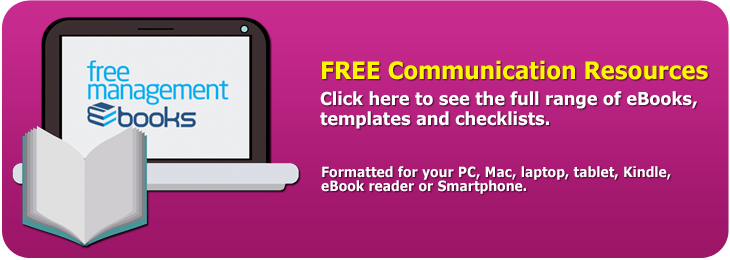Communication Skills - Audience Profiling
Several authors have attempted to make audience profiling scientific by assigning supposedly characteristic personality traits to particular types of job or levels of seniority. This type of audience profiling began in the 1960s with the work of Manning and Reece.
Their model for audience profiling suggests that members of your audience will fall into one of four categories - Supportive, Emotive, Directive, and Reflective. This provides you as a presenter with four discrete patterns of behavior that you can easily recognize and predict.
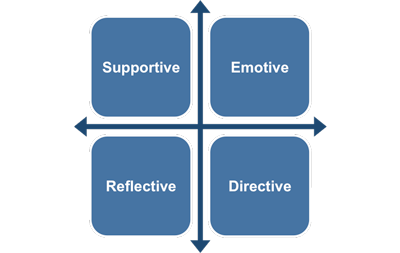 |
Each category has its own needs and preferences that give you general guidance on how they interact and relate to other people and is indicated by the axes.
Horizontal axis - represents the level of dominance an individual will display. (Low to High dominance from left to right.)
Vertical axis - represents the levels of sociability an individual shows in their behavior. (High to Low sociability from top to bottom.)
Manning and Reece went on to describe the traits associated with each personality type and provide presentation guidelines for each one. The diagram below gives you an overview of each type of personality you will find in your audience.
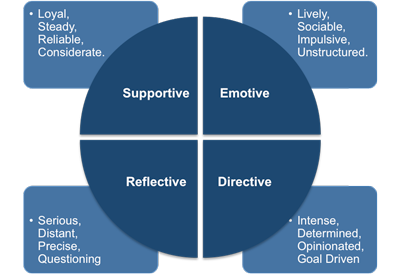 |
Their descriptions for each type are:
Supportive personalities - are high in sociability and low in dominance, often fearing change. They tend to be loyal, steady, solid, and reliable good workers.
Emotive personalities - are people-oriented, preferring broad pictures to too much detail. They tend to be sociable, animated, spontaneous, unstructured, and welcome change.
Directive personalities - are high in dominance but low in sociability. They tend to come across as intense, pushy, determined, and opinionated individuals who are often perceived as aggressive and unfriendly, especially if they encounter resistance to their goals at work.
Reflective personalities - are low in both dominance and sociability. These individuals tend to be serious, precise, and questioning, often appearing aloof and stuffy. They often occupy product-related jobs such as scientists and engineers in which it is beneficial to be attentive to detail.
What is important is that you are able to discern each of these personalities in your audience and the proportion of the total that each one represents. The following table provides you with some general guidelines for how to make your presentation match each type.
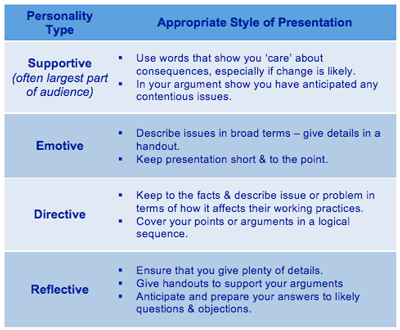 |
This type of audience profiling has been 'reinvented' many times since, usually as part of some new presentation method that is being sold. Whilst it may have value, in as much as it encourages you to think in a logical way about the likely make up of your audience, its use in the real world is limited because you simply cannot define people's personalities in such a simplistic way, and even if it were possible to do so, many audiences are fairly mixed.
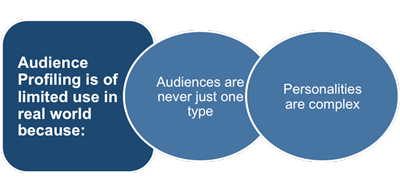 |
Even though profiling is an imperfect tool, it can help you understand your audience. However, you will also need to make a conscious effort to assess their needs as part of your planning in order to create an effective presentation that will resonate with them. There is no mystery to doing this - all you need to do is to think about what is important to your audience.
 |
For example, if you have been asked to present the benefits of a recent investment your audiences would have different needs:
• Your team or those lower in the organization need to know what the impact is on their day-to-day work.
• The executive need to know what efficiencies have been gained as against money spent and benefits accrued.
• Others, such as Users of a product, need to know what new benefits or features they now have.
Having already established what you need to communicate to your audience you must consider what they themselves want to get from the presentation. The best that you can hope for is that people will go away with an understanding of one main theme or at least the gist of what you are talking about.
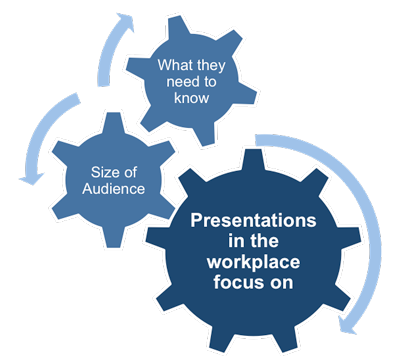 |
This may sound rather pessimistic, but in reality it is usually very difficult to achieve much more than this with the majority of any audience. A small percentage might be prepared to put in the required effort to follow your arguments and the finer points of your reasoning, but most will not.
Therefore, as part of you planning you must think carefully about the one thing you want your audience to remember. You have to be absolutely clear about it right from the start of your planning and preparation.
Once you have established the 'need' of your audience and the 'main' point you want them to walk away with you have to take into account the size of your audience. The bigger your audience the greater its diversity in terms of background and level of knowledge will be. Generally speaking, this means that the size of the audience will have a bearing on the level of complexity and detail that you can put into your presentation. In general the larger the audience the simpler the content needs to be.
Audience size will also have a bearing on the kind of visual aids that will be appropriate and whether or not you should rely on notes or a full script. Generally speaking, with small audiences it is inappropriate to read a speech verbatim from a text, whereas if you're addressing a large audience in a conference environment from a lectern then this method can be appropriate.
You may also be interested in:
Planning a Management Presentation | Everyday Management Presentations | Advantages and Disadvantages of Presentations | Four-Stage Presentation Planning Process | Presentation Environment | Define Your Key Message Statement | Outline the Scope of Your Presentation | Management Presentation Planning Guidelines.


